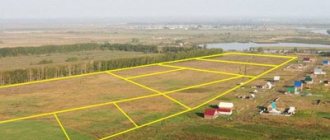Continue to next article
Earth is the most important natural resource, the basis of life. And that is the only reason why it is priceless. For many, the very question of the price of land seems fundamentally unacceptable. Jean-Jacques Rousseau exclaimed: “...you will perish if you forget that the fruits of the earth are for everyone, and that the earth itself is no one’s.” And one of the most prominent thinkers and writers in the United States, Ralph Waldo Emerson, Fr.
But people have been selling and buying land for a long time. And one of the urgent needs of the existence of the land market is the assessment of the value of land.
Purposes and types of land valuation
The purposes of land valuation may vary. Since a significant part of land is involved in civil circulation and is a commodity (while still remaining an important natural resource), for the full functioning of the land market, as mentioned above, an assessment of the market value of land, i.e., a monetary valuation of land, is vital. For example, when determining the price for a purchase and sale transaction of a plot.
According to the Land Code of the Russian Federation, payment for the use of land is one of the basic principles of land legislation. The principle of payment is intended to stimulate the rational use, protection and development of land, increase soil fertility, and help level out the socio-economic conditions of management. The main way to implement it is taxation. And in order to calculate the amount of land tax, a universal basic indicator is needed, which is currently established for the cadastral valuation of land (land plots) in the Russian Federation. Therefore, the tax burden as payment for land and land valuation are closely related. According to Federal Law No. 137-FZ of October 25, 2001, in cases where the cadastral value of land is not determined, for the purposes specified in Article 65 of the Land Code of the Russian Federation, the normative price of land is applied.
The normative assessment of land gives reason to recall the Law of the RSFSR of October 11, 1991 No. 1738-1 “On payment for land”. Since January 1, 2004, this law has been declared repealed with the exception of Article 25, which talks about the standard price of land: “The standard price of land is an indicator characterizing the cost of a plot of a certain quality and location, based on the potential income for the estimated payback period.”
The state cadastral valuation of land is carried out in accordance with the Rules for the state cadastral valuation of land, approved by Decree of the Government of the Russian Federation of April 8, 2000 No. 316.
Mandatory for use when determining the cadastral value of land plots, information about which is contained in the state real estate cadastre on the date of assessment, is the Federal Valuation Standard “Determination of Cadastral Value (FSO No. 4)”, approved by the Order of the Ministry of Economic Development of the Russian Federation of October 22, 2010. No. 508.
State land assessment is carried out to determine the cadastral value of land plots for various purposes at least once every five years.
The results of the state cadastral valuation of land are approved by the executive authorities of the constituent entities of the Russian Federation on the proposal of the territorial bodies of the Federal Real Estate Cadastre Agency. The results of the cadastral valuation of land are entered into the state land cadastre.
Cadastral valuation of land is based on the classification of land according to its intended purpose and type of functional use.
The state cadastral assessment of land takes into account data from land, urban planning, forestry, water and other cadastres.
Knowing the cost of land is necessary in a number of other cases. In particular:
- when transferring a plot for rent or collateral;
- lending;
- insurance;
- contribution to the authorized (share) capital;
- making management decisions;
- preparation of financial (accounting) statements;
- withdrawal for state needs;
- determining the value of the debtor's property during bankruptcy proceedings;
- determining the value of property received free of charge;
- resolution of property disputes.
Confiscation of land plots by the state
The state can seize land plots for the following purposes: for the development of the site, for the placement of objects of national importance on it (defense facilities, construction of new buildings, energy facilities, etc.), for the construction of communications routes, etc. And in cases where private lands are confiscated, the role of the appraiser is very important, because when plots are confiscated, the redemption price must be paid to the owners of the plots. This provision follows from Article 55, which states that the forced seizure of plots for municipal and state needs can only be carried out subject to equal compensation for the cost of the plot. And here this point is very important for the appraiser - the redemption value of the plot differs from its immediate market price. Yes, the market price of the plot is included in the redemption price, but in addition to it, the redemption price also includes losses incurred by the owner as a result of the seizure, lost profits, and possibly other losses during the seizure. Since the seizure occurs by court decision, it is determined by law It is the appraiser who must redeem the redemption value upon seizure. The state appraiser wins the bidding for the right to conclude a contract. But the owner also involves his appraiser. And here a small kind of “conflict” arises.
To better clarify the legality of appraisers’ actions in such cases, let’s turn to Federal Law No. 159 “On the specifics of the alienation of real estate in state ownership of the Russian Federation or in municipal ownership and leased by small and medium-sized businesses and amendments to the legislation of the Russian Federation”, and also try to answer the following questions: Some questions. The following questions arise here: does Federal Law No. 159 apply to entities operating on a sublease basis?
No, in fact, this law does not apply to small and medium-sized businesses that use property on a sublease basis, because subtenants have contractual relations not directly with the owner of the site, but with the primary tenant. And the direct owner does not have any obligation to alienate his property. The next question is how many times can a small and medium-sized business entity repeatedly apply for the exercise of the right to buy out the same leased property? Law No. 159 does not provide for restrictions on the number of repeated applications, which makes it possible to apply for the exercise of redemption rights an unlimited number of times.
Questions also arise: should the encumbrance of the property with a lease right be taken into account when determining the market value? The answer to this question is that it should not, since taking this encumbrance into account can lead to an underestimation of the value of the site. Does the buyer, who purchased the property on the basis of 159 Federal Laws, have the right to exercise the rights of the buyer provided for in paragraph 1 of Article 475 of the Civil Code of the Russian Federation when transferring goods of inadequate quality? Yes, you have the right, since Federal Law 159 does not provide for the legal aspects of resolving disputes that may arise after the transfer of rights to property that has defects not specified in the purchase and sale agreement.
When transferring ownership of a land plot, the transfer of rights is not subject to VAT. Not all appraisers are familiar with this point, but it is imperative to know it. This provision is spelled out in subclause 6 of clause 2 of Art. 146 of the Tax Code. But when selling lease rights to a plot (namely lease rights, not ownership), this situation changes and VAT must already be taken into account when assessing.
When assessing, easement issues should not be forgotten.
Often it can completely limit the rights of the owner of a land plot to use it. This often happens when a road is built through a particular site and the owner of the site cannot do anything about it, and cannot derive any benefits from it. Accordingly, in fact, this part is already leaving the property, and the question arises, how much will such a plot cost then? It is absolutely impossible to deduct the cost of such a part, because it is still part of the whole plot, but it is also impossible to consider it as a full-fledged piece of land. The most correct decision here would be to evaluate this part (allotted for construction) as an encumbrance.
And based on this, calculate the cost of such a plot. Although the issue of easements deserves separate discussions, as does each individual case of encountering easement problems. It is important not only to estimate the cost of plots, but also to correctly format and present your estimates. To present his findings, the appraiser draws up a special report, the form of which is regulated by federal standards.
The structure of the report is as follows:
Assessment task. Assumption of a restrictive condition. Applicable standards of valuation activities. Introduction, purpose of assessment, terms, definitions. Assessment objectives, date, assessment procedure. Description of the object of assessment. Regional analysis. Analysis of the most effective use. Review of the market for the subject to be assessed. Macroeconomic analysis, valuation methodology, assessment of the market value of a land plot. Regulatory framework, sources of information, quality certificates.”
Here, analyzes of the market and market value present great difficulties, because they are not readily available, which means that all this information must be collected “from scratch.” Many appraisers do not take into account encumbrances that can greatly spoil the entire report. There is also a law according to which the appraiser, having realized the complexity of the task facing him, can refuse to evaluate. For example, a situation may arise where the site is entirely located in the area of a power line, or a power line with a highway.
When preparing a report, the correct selection of analogues is very important, otherwise the assessment will be considered incorrect. For example, when selecting analogues, the appraiser may take into account the supply of communications at both one and the other site, but will not take into account that at one site the communications are connected and ready for operation, while at the other site it is necessary to spend money to connect and fully use these communications.
By the way, since we are talking about plots, it is impossible not to mention the fact that the law prohibiting registration on dacha plots for agricultural purposes has been abolished. Those. Now you can register at your summer cottage almost without problems. But still, the decision to build housing on such a plot is often made through the court, which means that this factor must also be taken into account when assessing the value of such a plot of land. Even when selecting analogues in the assessment of a site, distance from the reservoir plays an important role. Therefore, you should focus on this factor, otherwise failure to take it into account will also negatively affect the accuracy of the assessment.
And there is also a requirement for appraiser reports, which is that all information must be verifiable. That is, when the appraiser makes some conclusions based on information from some sources, he must clearly indicate these sources; if the information was taken from a specific person, then the report must contain contacts of this person. And, in conclusion, it must be said that neither this article, nor even the entire legislation of the Russian Federation fully provides for all the issues that may arise when assessing land plots. This means that in each case the appraiser will have to rely not only and not so much on laws and regulations, but on his own experience and intelligence.
We recommend
Evaluation Features
gas stations.
Get useful skills for assessing gas stations! https://shop.kerzhaev.ru
Analysis of FSO No. 7. Questions and answers
Get the book right now!
https://shop.kerzhaev.ru
“Analysis of FSO No. 8” Business valuation.
Find out how to correctly apply the provisions of the standard in practice!
https://shop.kerzhaev.ru
Analysis of FSO No. 10. Estimation of the cost of machines
and equipment.
Be the first among appraisers! https://shop.kerzhaev.ru
"Analysis of FSO No. 11"
Valuation of intangible assets and intellectual property.
Click to find out more! https://shop.kerzhaev.ru
Rating 5/5 (1 Review)
Cadastral valuation of lands in settlements
The Methodological Guidelines for the state cadastral valuation of land in populated areas, approved by Order of the Ministry of Economic Development and Trade of the Russian Federation dated February 15, 2007 No. 39, help determine the cadastral value of land plots with different types of permitted use on the lands of settlements.
Carrying out a cadastral valuation of land in settlements consists of two stages: creating a list of land plots and calculating their cadastral value.
State cadastral valuation of urban lands, rural settlements, horticultural, gardening and dacha associations is carried out on the basis of statistical analysis of market prices and other information about real estate, as well as other methods of mass real estate valuation.
Cadastral valuation of agricultural land
The state cadastral assessment of agricultural lands outside the boundaries of urban and rural settlements and with the exception of areas located within the boundaries of horticultural, gardening and dacha associations, as well as the assessment of forest lands (forest fund lands), is carried out on the basis of capitalization of estimated rental income.
Order No. 445 of the Ministry of Economic Development of the Russian Federation dated September 20, 2010 approved the Methodological Guidelines for the state cadastral valuation of agricultural land.
The assessment is carried out in three stages:
- formation of a list of land plots;
- determination of specific indicators of their cadastral value;
- cost calculation.
The list of sites is compiled by the regional department of the Federal Service for State Registration, Cadastre and Cartography (Rosreestr) as of January 1 of the year of work. It must contain information about all lands located in the assessed territory.
Specific indicators of land plots depend on the type of their use.
Determining the specific indicators of the cadastral value of land involves, among other things, calculating the costs per unit area for maintaining soil fertility for each crop rotation.
The cadastral value is calculated by summing the products of specific indicators and areas occupied by these lands within the boundaries of the site.
The cadastral value of land plots as part of agricultural land is determined as of January 1 of the year of work on the state cadastral valuation of agricultural land on the territory of a constituent entity of the Russian Federation.
The concept of “economic valuation of land” was provided for in the regulatory documents of the pre-reform period. This assessment of the condition of the land served to determine the comparative value of plots of land as a means of production in agriculture. Its indicators depended on the natural (or artificial) fertility and natural and economic conditions of the area where the land plots were located.
Existing methods and criteria
Cadastral valuation of land plots is carried out by the Federal Real Estate Cadastre Agency, its regional bodies, organizations and enterprises under their management. Persons licensed to conduct assessments have the right to work in this area.
There are land valuation methods , which are divided into 2 approaches:
- profitable;
- comparative.
The income approach includes methods
- intended use;
- capitalization of land rent;
- remainder method.
The intended use method is used to determine the value of properties (built and undeveloped) for the purpose of generating income by developing improvements on the site.
The ground rent capitalization method is used to evaluate objects in order to obtain ground rent. Both developed and undeveloped areas can be assessed. To use this method, land rental rates must be processed and their value determined as rental income. The rental fee is determined by the location of the property, its size, function, shape, availability of communications, accessibility of vehicles, and type of land use.
The residual method is used to evaluate land properties and makes it possible to generate income. Also, as in the capitalization method, both developed and undeveloped areas can be assessed. To apply this method, first of all, you need to determine the value of the land that can be improved for the purpose of making a profit. Next, income is capitalized by establishing income from the facility and buildings.
The comparative approach includes methods
- discharge;
- distribution;
- sales comparisons.
The allocation method is used to evaluate land parcels to determine whether improvements to the land correspond to its highest and most efficient use. This method is only suitable for built-up areas.
The distribution method is used to evaluate land plots in order to establish the relationship between the value of the land and the buildings built on it. Used for built-up objects. Most suitable for new buildings, as they must comply with the efficient and rational use of land. To use the distribution method, you need to have information about the relationship between the price of the plot and the buildings erected on it. However, the result will not be accurate.
The sales comparison method is used to compare the prices of similar land. It is one of the simplest and most effective. Gives fairly accurate market indicators. However, for the Russian market, which is not information-open, the mentioned method is not suitable. Its use is influenced by the market situation, site location, terrain, soil properties, application options, ownership, etc.
Land assessment criteria:
- site location;
- availability of communications and the ability to connect them if they are absent;
- transport accessibility to the land plot;
- purpose of use and the possibility of changing its purpose;
- data from geological and geodetic research.







